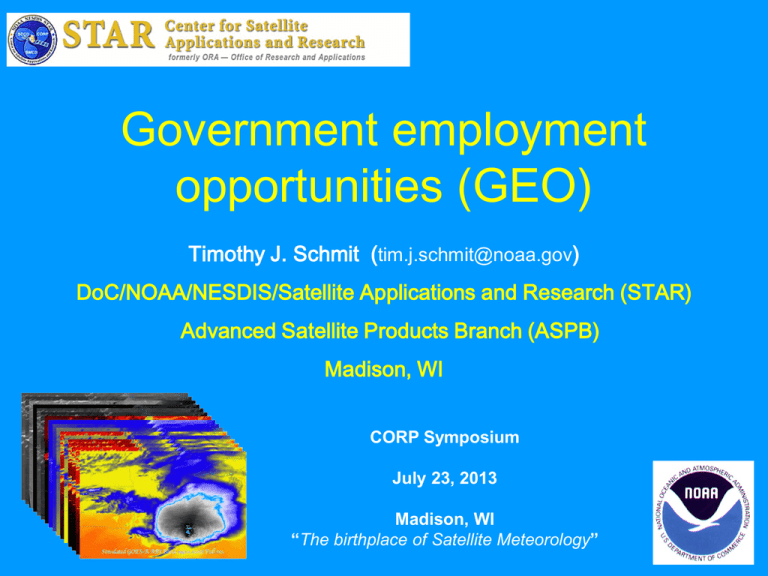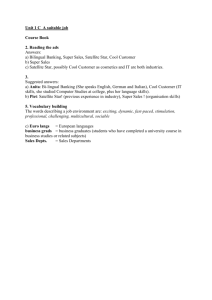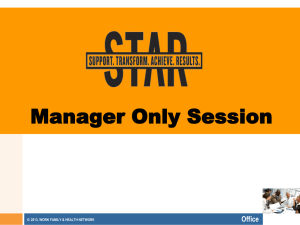Government employment opportunities (GEO)
advertisement

Government employment opportunities (GEO) Timothy J. Schmit (tim.j.schmit@noaa.gov) DoC/NOAA/NESDIS/Satellite Applications and Research (STAR) Advanced Satellite Products Branch (ASPB) Madison, WI CORP Symposium July 23, 2013 Madison, WI “The birthplace of Satellite Meteorology” 1 Outline • Introduction • The ‘graying’ of the workforce • Options • Logistics • “Tips” and Links • Questions 2 1966: ATS-1 launched • Applications Technology Satellite (ATS)-1 was the first geostationary imager, launched 6 December 1966. Imaging instrument designer and SSEC (Madison, WI) co-founder, Verner E. Suomi, proclaimed, “the clouds move, not the earth”. 11 December 1966 3 GOES-14 Imager SRSOR special imagery showing rapid development during a data gap associated with a Full Disk scan on 12 June 2013. (Or, ‘what can happen during one Full Disk scan?) 5 GOES-14 SRSOR 6 SRSOR from GOES-14 • More days of SRSOR expected in mid-August. • http://cimss.ssec. wisc.edu/goes/sr sor2013/GOES14_SRSOR.html 7 ABI Spectral Bands ABI Scans (in 30 min) Full Disk (2X) CONUS (6X) Mesoscale (60X) The next generation geostationary imager offers more bands, more often Outline • Introduction • The ‘graying’ of the workforce • Options • Logistics • “Tips” and Links • Questions 9 Lockheed Martin STAR WORKFORCE Age Distribution Center for Satellite Applications and Research (STAR) 2009 Federal Employee Staff by Age Grouping 40 Number of People Per Category 35 30 25 20 15 10 5 0 <21 21-30 31-40 41-50 5l-60 >60 Approximately 40% of STAR’s workforce retired in the last 5 years 40% of STAR’s workforce MAY RETIRE in the next 5 years Center for Satellite Applications and Research (STAR) Review 09 – 11 March 2010 10 STAR FACTS Civil Servant Staffing Available 1987 FTE positions: 140 YEAR: STAR workforce planning is essential to maintain a viable science office Center for Satellite Applications and Research (STAR) Review 09 – 11 March 2010 11 STAR WORKFORCE NUMBER OF RECENT HIRES 14 12 10 8 6 4 2 0 2005 2006 2007 2008 2009 2010 2011 2012 Turnover of STAR workforce may impact future readiness Center for Satellite Applications and Research (STAR) Review Turnover of STAR workforce will impact future readiness 09 – 11 March 2010 12 Outline • Introduction • The ‘graying’ of the workforce • Options • Logistics • “Tips” and Links • Questions 13 Lockheed Martin Four Pillars of NOAA Observations Computation & Modeling Critical Environmental Intelligence People are key for each pillar! People Research Options • NOAA/NWS or NOAA/NESDIS • DOE or DOI or EPA or FAA or NASA • DoD (Airforce, Navy, etc.) • “Government-support” – NOAA Cooperative Institutes, etc. – Contractors 15 Details • NOAA/NWS: operational forecasters, modelers (NCEP), hydrologist, NHC, HPC, OPC, AWC, SPC, etc. • NOAA/NESDIS: Satellite algorithm/product development and research; satellite operator, volcanic ash advisory, synoptic analysis, etc. • NOAA/NESDIS/OAR: research, surface observing, etc. 16 Details • • • • • • • NASA: satellite products, research, etc. DOE (Energy): solar, etc. DOI (Interior): wildfires, etc. EPA: air quality, etc. DOA (Agriculture): researcher, etc. FAA: 4-d data cube, hazards to aviation DoD (Airforce, Navy, etc.) – Operational forecasts – Modelers – Etc. 17 Details • “Government-support” – NOAA Cooperative Institutes, UCAR, etc. – http://www.nrc.noaa.gov/ci/locations/index.html – Research on many topics – Contractors – http://www.corpblogspot.org/ – Full range of support from operations to IT to research – http://www2.ucar.edu/opportunities 18 CIMSS Personnel (now 136) Cooperative Institute for Meteorological Satellite Studies University of Wisconsin - Madison Outline • Introduction • The ‘graying’ of the workforce • Options • Logistics • “Tips” and Links • Questions 20 Lockheed Martin https://www.usajobs.gov/ Watch close dates. https://www.usajobs.gov/studentsandgrads US Bureau of Labor Statistics: http://www.bls.gov/ooh/Life-Physical-and-SocialScience/Atmospheric-scientists-including-meteorologists.htm#tab-6 Atmospheric scientists…projected to grow by 11%... 28 US Bureau of Labor Statistics: • Prospective atmospheric scientists should expect competition because the number of graduates from meteorology programs is expected to exceed the number of job openings. • Workers with a graduate degree should enjoy better prospects than those whose highest level of education is a bachelor’s degree. • Competition may be strong for research positions at colleges and universities because of the limited number of positions available. • Few opportunities are expected in federal government because atmospheric scientists will be hired only to replace workers who retire or leave for other reasons. • The best job prospects for meteorologists will be in private industry. 29 Outline • Introduction • The ‘graying’ of the workforce • Options • Logistics • “Tips” and Links • Questions 30 Lockheed Martin “Tips” • Gain experience to stand apart – Take more courses than required – Consider getting a minor – Get a masters degree – Computer skills (programming, web, etc.) – Consider for internships, coops, Student Career Experience Program (SCEP), etc. – Business / management courses 31 “Tips” • • • • • • • • "You can't teach enthusiasm!“ Do your homework about the agency/group Be flexible wrt location, other options await Join profession groups (NWA, AMS, etc.) “You only need one job” Don’t be shy – advertise yourself Get involved, network (+ social media) Investigate ‘government-support’ positions, such as at NOAA Cooperative Institutes or 32 contractors Select Links • https://www.usajobs.gov/ • http://www.careers.noaa.gov/special_programs.html • http://www.theweatherprediction.com/jobs/ • http://www.navy.com/careers.html • http://www.airforce.com/careers/ • http://jobs.faa.gov/ • http://www.bls.gov/ooh/Life-Physical-and-SocialScience/Atmospheric-scientists-includingmeteorologists.htm • http://www.nwas.org/jobs.php (member portal) 33 Outline • Introduction • The ‘graying’ of the workforce • Options • Logistics • “Tips” and Links • Questions 34 Questions? 35


